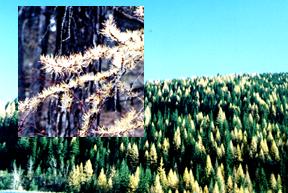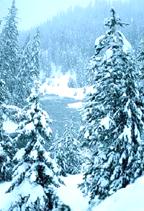Because the climate of the taiga is very cold, there is not a large variety of plant life. The most common tree found in the taiga is the conifer--trees that have cones. Four kinds of conifers are common in the taiga. Three of the common conifers are evergreens; spruce, fir, and pine. The fourth common conifer is the tamarack, or larch, a deciduous tree. Under certain conditions, broad leaf trees, such as birch and aspen, are able to survive the harsh climate of the taiga.

Plant adaptations
Evergreens use a wide variety of physical adaptations. Some of these adaptations include their shape, leaf type, root system, and color. Their name, evergreen, describes an important adaptation. They are always--or ever green. Because they don't drop their leaves when temperatures cool, they don't have to regrow them in the spring.
Growing new leaves takes a lot of energy. Plants get their energy from the soil and from the Sun. Soil is a source of nutrients. Sunlight is necessary for photosynthesis to take place in the plant. The taiga soil doesn't contain many nutrients, and the Sun usually remains low in the sky. These two factors limit the amount of energy available to the tree. By keeping their leaves, the evergreens are able to use that limited energy for structural growth rather than producing leaves.
 Although the taiga has moderately high precipitation, the ground freezes during the winter months and plant roots are unable to get water. The adaptation from broad leaf to narrow needle-like structures limits water loss through transpiration. Evergreen needles do not contain very much sap. This limits the risk of needle damage from freezing temperatures. The needles do, however, contain a chemical that repels animals who would eat the needles. The dark green color of the needles absorbs the sunlight, and since the needles are always present, once temperature start to get warm, photosynthesis quickly begins. The conical shape of the evergreens allows the snow to slide off the branches rather than pile up. If the snow can't pile up on the branches, there is less risk of broken branches due to the weight of the snow.
Although the taiga has moderately high precipitation, the ground freezes during the winter months and plant roots are unable to get water. The adaptation from broad leaf to narrow needle-like structures limits water loss through transpiration. Evergreen needles do not contain very much sap. This limits the risk of needle damage from freezing temperatures. The needles do, however, contain a chemical that repels animals who would eat the needles. The dark green color of the needles absorbs the sunlight, and since the needles are always present, once temperature start to get warm, photosynthesis quickly begins. The conical shape of the evergreens allows the snow to slide off the branches rather than pile up. If the snow can't pile up on the branches, there is less risk of broken branches due to the weight of the snow.
No comments:
Post a Comment